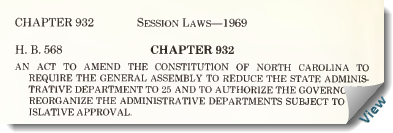
The General Assembly of 1969 approved seven amendments to the state constitution to be submitted to the North Carolina electorate. On 3 Nov. 1970 voters accepted six of these amendments, one of which required the legislature to reduce the more than 300 administrative departments, agencies, and offices to no more than 25 principal departments by 1 July 1975. To make the administrative structure more manageable and more efficient, the General Assembly in 1971 passed the first of two Executive Organization Acts. This law created 19 principal offices or departments, 10 of which-governor, lieutenant governor, secretary of state, state auditor, state treasurer, superintendent of public instruction, attorney general, and commissioners of agriculture, labor, and insurance-were to be popularly elected. The other 9 departments, including those covering transportation, commerce, cultural and natural resources, and military affairs, were to be headed by gubernatorial appointees.
This reorganization was favorably received by the majority of legislators and influential state newspapers. In a speech to the General Assembly two months before the measure was passed, Governor Robert W. Scott asserted that "through a consolidation of departments, agencies, and boards performing the same or similar functions, we will be in a position to demand that the units of governmental management get in step with one another." Scott left office in January 1973 convinced that his plan for reorganization would be implemented by his successor, and that subsequent administrations would complete it.

The second phase of reorganization, the Executive Organization Act of 1973, was passed early in the administration of Governor James E. Holshouser Jr., the first Republican governor elected in twentieth-century North Carolina. This law affected only the Department of Cultural Resources (the new name, effective 1 July 1973, of the Department of Art, Culture, and History), the Department of Human Resources, and the Department of Revenue. This reorganization and others of later years received less attention than had the 1971 law. A flurry of media attention did occur following the announcement in December 1973 that H. G. Jones, director of the Division of Archives and History of the Department of Cultural Resources (and its predecessor, the Department of Archives and History), intended to resign in protest of the reorganization. Within two years, other critics had joined Jones in declaring that the state reorganization was a failure. Some argued that the state government had become more remote and costly rather than more efficient and responsive, citing the creation of hundreds of middle-management jobs, with many employees drawing executive salaries for jobs once done by lower-level employees. In many cases department heads were given salaries double the original salary, and numerous lower-level bureaucrats were suddenly elevated to deputy or assistant department heads with their salaries increased accordingly.

In 1979-more than six years after he had left office former governor Scott charged that the Holshouser and James B. Hunt administrations had not been "serious enough about government to make . . . reorganization of state government work effectively." Although their success is debatable, the acts of 1971 and 1973 permanently changed the structure of North Carolina state government.